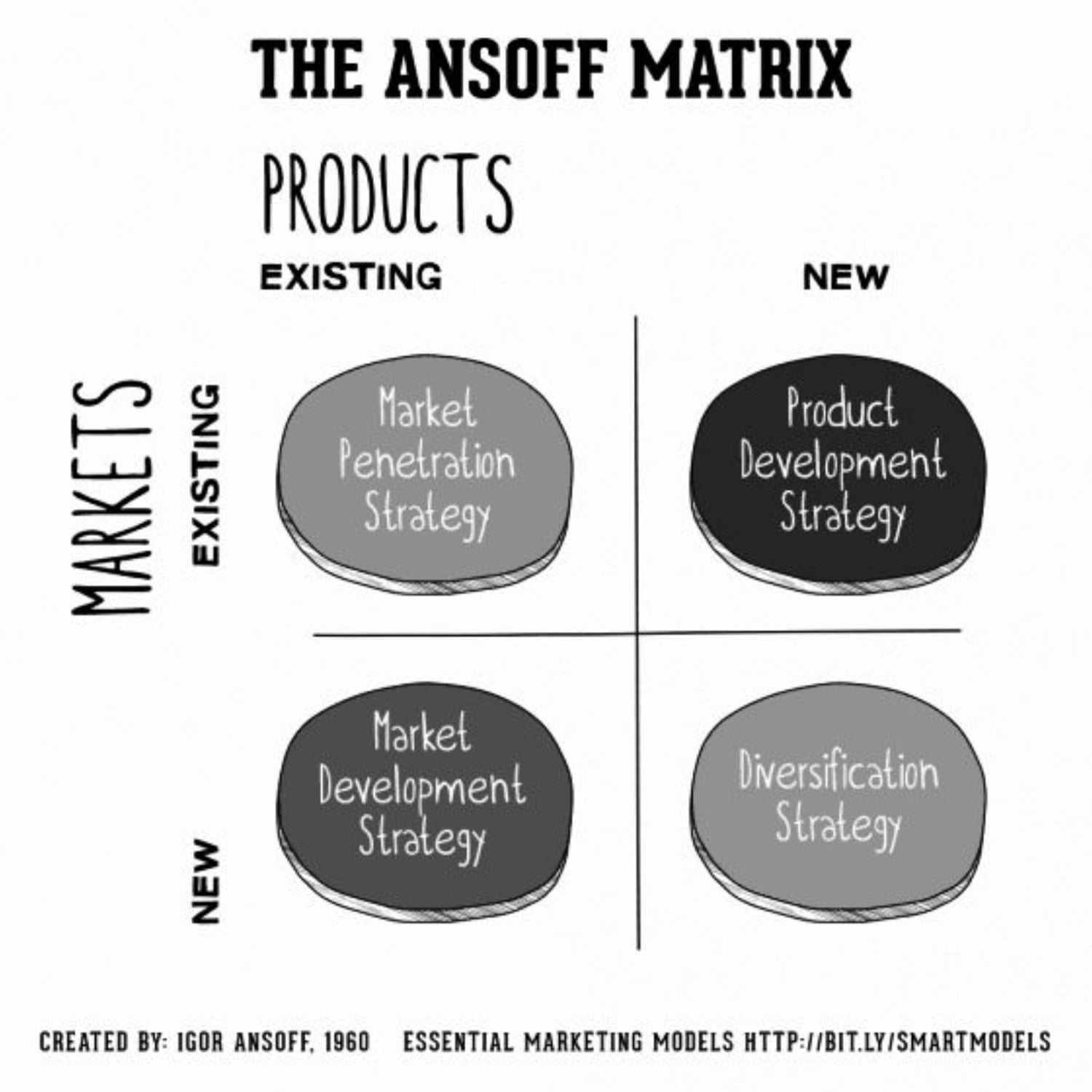Revenue ideas in a crisis.
20 ways to drive more sales, donations, and investment… without spending money

KEVIN L. BROWN
The social ventures we’ve been guiding in this crisis are in radically different places. Some with months of cash in the bank. Others on the brink of insolvency.
The one thing in common? Revenue is keeping most leaders up at night. Whether it be sales, donations, or investment.
But a crisis is not the time for any nonprofit or social enterprise brand to attempt dramatic shifts in their revenue model. Using the Ansoff Matrix as a framework, a pandemic isn’t the best chance to enter new markets. Much less take new products into new markets. But we can think about selling more within existing segments. And offering new products to current constituents.
It’s a lot like searching for coins in between the couch cushions. Crises force social entrepreneurs to get creative with what we’ve got, optimize existing opportunities, and pick up smaller chunks of new revenue where we can.
On that note, if you’re struggling with revenue, here’s one approach. Can you do 20 things 5% better instead of attempting a 100% shift? We’ve rattled off countless ideas for small improvements to help our clients drive more revenue. Some may apply to your organization, some not. Some may work, some not.
If you need to drive more income in short order, here’s a list of 20 revenue ideas to consider trying today. None of which involve spending money to make money.

MODELING
1. Ideate new products and offers.
Use this creative matrix or wall of ideas to iterate your existing programs or products. Then lay out new ideas in a two-by-two innovation matrix to decide which are worth pursuing, and which you should park for now.
2. Establish a sales funnel.
Map out in writing your customer or donor journey. Even you nonprofits. From initial awareness and high-level messaging, to conversion points and retention campaigns. Needless to say, if you don’t know your existing sales funnel, you can’t optimize it.
3. Create a revenue dashboard.
Along with the sales funnel, create a revenue dashboard. And watch it like a hawk — daily and weekly. From donors to customers and all other income like institutional funding — before you can try new ideas, you have to know what moves the needle.
“Understand your value. Learn how to package it. Sell it. Repeat.”
ARIEL LOPEZ, KNAC
POSITIONING
4. Tell your same story, just better.
5. Bundle and package your appeals.
In a pandemic world, money is tight and time limited. Take your offers and create discrete ‘products’ of value for customers. The same way Mighty Ally packaged three existing services into lower-priced COVID-19 solutions to address higher-order, current concerns.
6. Tighten up positioning.
It sounds counter-intuitive, but social ventures can drive more revenue, not less, by doing fewer things. Tight positioning leads to focus which leads to more sales and funding. Because people trust your expertise and ability to execute.
“There has never been a better time to clarify your positioning and become more relevant to fewer people. There’s no better time to gather an audience losing sleep over something that you are an expert at solving for them. What are you uniquely qualified for?”
DAVID C. BAKER, RECOURSES
PRICING
7. Implement value-based pricing.
Whether you’re selling products or programs, don’t just calculate costs plus markup and set a price. Determine the value you’re providing your clients or customers, and work backward to set your fees. That’s value-based pricing.
8. Split out ancillary products.
Learn from airlines and think about your ancillary items (like checked bags and premium seats). Sell your core products and services, with extras priced… extra. But don’t alienate your customers with this revenue management technique.
9. Write proposals using three tiers.
When you’re delivering a donor proposal or customer quote, always give three options. Because three options increase your ‘win rate’ from 50% to 75%. And don’t forget to always anchor high — you’ll increase revenue by at least 20%.
10. Don’t cut price, add value.
If a constituent or investor seeks a reduction in your fees, think twice before discounting. Instead of cutting your price (lost revenue!), offer instead keeping costs the same but adding value. That’s a win, win.
11. Consider pay-what-you-can.
Even social ventures serving the poor can charge something for their work. Some form of payment, determined by your constituent, can actually bring dignity to the transaction. Plus revenue to your organization in this critical time.
“The goal of value-based pricing is not to charge more — that’s merely a beneficial consequence. The goal is to create an organization that is intently focused on creating extraordinary customer value. That means developing in your frontline people that same skill that your friend has: the ability to have a conversation with a client and have the entire focus of the conversation be on her. What does she want? What is valuable to her? What is she willing to pay for?”
BLAIR ENNS, WIN WITHOUT PITCHING
ECOMMERCE
12. Optimize digital experiences.
If you’re making money online, optimize your site and landing pages. Make it easy to buy what you sell or donate to your cause. Look at conversion rates and average time on site. Reduce content, use a single call-to-action, and cut down the noise.
13. Track your falloff & failures.
Even when your website is solid, many customers or donors don’t complete their checkout process. Investigate where and why. Contact those whose credit cards failed. And watch abandoned transactions as much as successful ones.
14. Turn one-offs into repeats.
Contact all your one-time donors or customers and ask them to repeat. Even if it takes days of personal emails and calls. Because it’s always easier to retain those you have now or re-engage lapsed buyers than it is to find new ones.
15. Set up sponsorships.
If you work with smallholder farmers, give donors a chance to sponsor a family. If you deliver education training for schools, get a corporate partner to sponsor a classroom. Tangible, visible funding opportunities are critical right now.
“If I’m being bombarded with information that I don’t need, my brain recognizes it as noise and tunes out. But when you give your message structure and clarity, the brain knows how to engage, follow along, and remember.”
DONALD MILLER, STORYBRAND
OTHER
16. Offer expertise in trainings.
You’re likely an expert in something — a topic related to your mission. If your traditional revenue has dried up, can you sell your expertise to others? Think of one-to-many workshops, webinars, or trainings that you can charge for.
17. Launch a referral campaign.
Without creating any official program, ask your best customers or funders for referrals. Many times, your best brand ambassadors need to be prompted to tell others. But they would be happy to do so. And could help drive new revenue overnight.
18. Sell discounted gift certificates.
If the lockdown has grounded your program or product delivery, can you sell ‘gift cards’ for customers to redeem in the future? Practically any social venture with a revenue model can sell now and deliver later (with local laws applicable).
19. Provide after-sales services.
A product or service sale is one step in the revenue puzzle. What are the other ways you can win in the aftermarket? Think like an automobile dealership, which makes more money in parts and services than new car sales.
20. Get creative with payment terms.
In this crisis, customers and funders might try to pull back on commitments. But instead of letting them go and writing off the losses, get creative by offering terms or financing. 100% of revenue over time is better than less revenue today.
“Survive, maintain, respond. Non-profit organizations need to enter the next 12 months with a firm grasp of the money they can count on and the choices it gives them. With good planning, you can weather the hard days ahead and come out stronger on the other side.”
LAURA HATTENDORF, MULAGO FOUNDATION
Read more articles
Ready to get fundable and findable?
We engage three ways: consulting, training, and field building.
